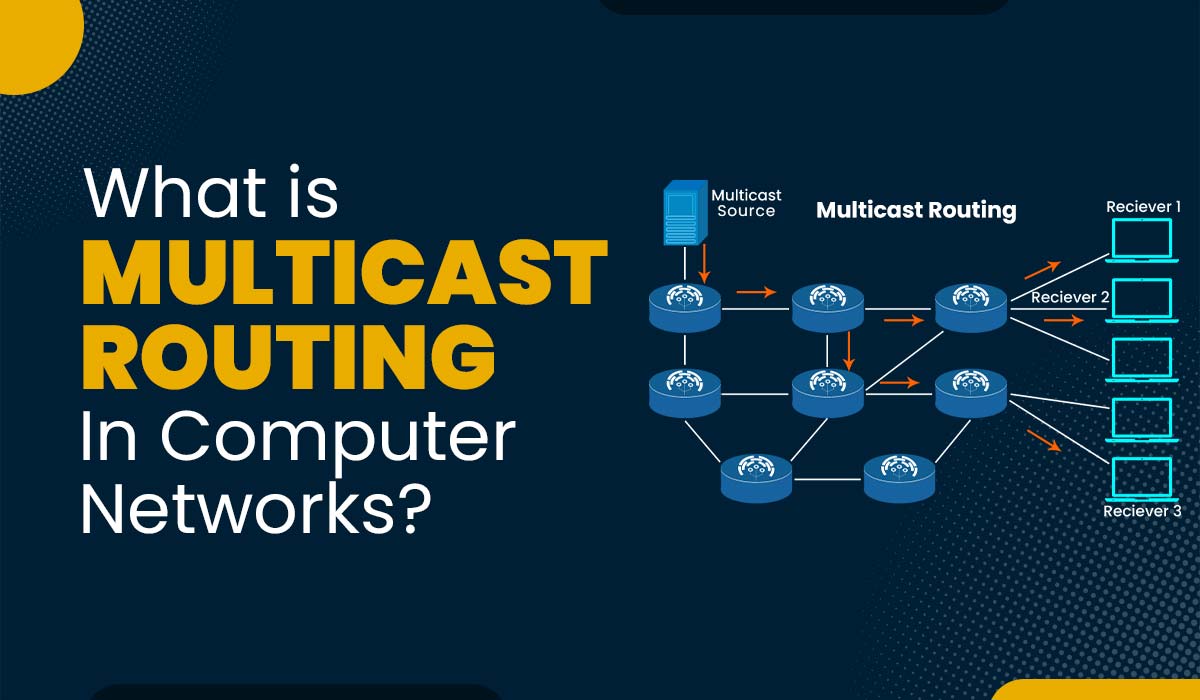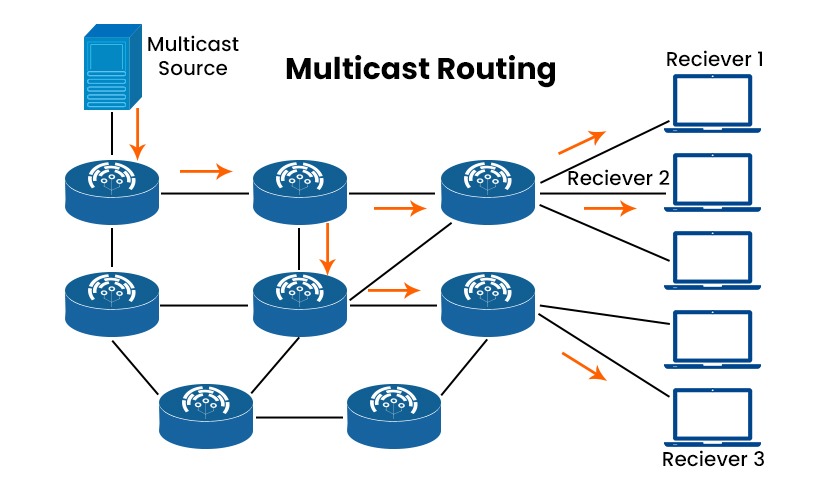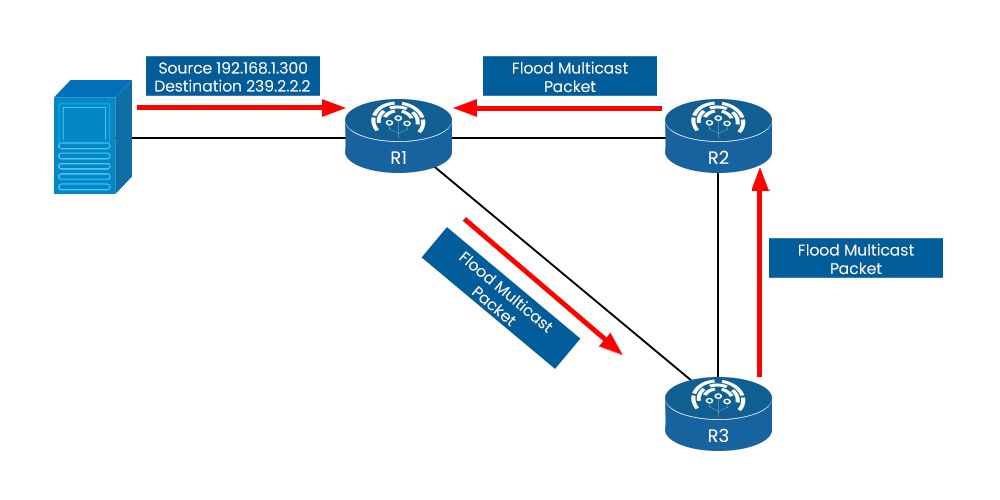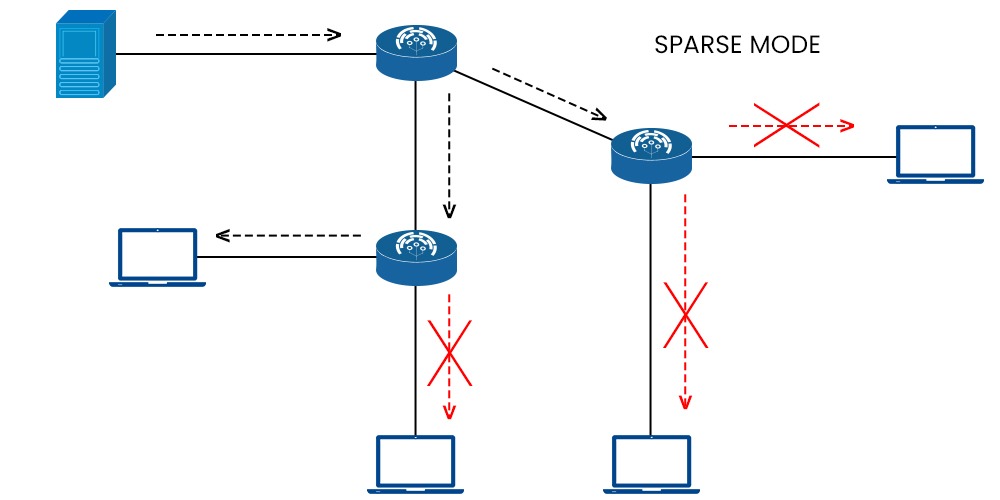What is Multicast Routing in Computer Networks?

A wide range of newly developed network applications need packets to be sent from one or more senders to several receivers. These include shared data applications, data feeds (like stock quotes), interactive gaming (like distributed multiplayer games like CSGO), streaming continuous media (like the transfer of the audio, video, and text of a live lecture to a group of distributed lecture participants), and bulk data transfer (like the transfer of a software upgrade from the software developer to users needing the upgrade). A very helpful concept for all these applications is multicast. With multicast, a packet is sent from one sender to many recipients using just one “transmit” operation. In this blog, we will explain what multicast routing is, its purpose, and the different protocols used to implement it. Let’s start by first understanding the multicast routing in detail. Multicast routing is mainly used to transmit data from one or more sources to multiple destinations. Unlike unicast routing, which sends copies of data to each destination, multicast routing sends a single copy of data to a group of destinations that require it. This helps reduce consumption, network load, and processing overhead on the sources. For multicast routing, special IP addresses known as Class D addresses are utilized. These addresses range from 224.0.0.0 to 239.255.255.255. These are not assigned to any host or interface but represent groups of hosts interested in receiving the same data. For instance, 224.0.0.1 represents all hosts on the network, while 224.0.0.9 represents all routers. To join a multicast group, a host sends a message via the Internet Group Management Protocol (IGMP) to its router, which then forwards it to other routers in the network using Protocol Independent Multicast (PIM). PIM’s role is to construct and maintain trees that establish paths connecting sources and destinations for multicast data. The primary objective of multicast routing is to optimize the delivery of data to multiple receivers within the network. By sending one copy of the data to each group of receivers, multicast routing conserves bandwidth and reduces network congestion. This will also enhance scalability. Generally speaking, multicast requires low bandwidth because it transmits one information stream. This makes it particularly suitable for handling high volumes of data across software and technologies such as media. There are various applications of multicast routing. The most popular uses of multicasting include videoconferencing and streaming media on organizational networks such as hotels or campuses. Multicast routing has numerous other uses, such as online gaming, distance learning, and stock market updates. Multicast routing protocols are classified into two categories: dense mode and sparse mode. Dense-mode protocols assume that most nodes in the network are interested in receiving multicast data, while sparse-mode protocols assume that only a few nodes are interested. Different protocols may be suitable for different scenarios depending on the network topology and traffic pattern. Let’s discuss these two categories in detail. Dense mode protocols assume that there are many receivers in the network and use flooding to send data packets to all nodes. Then, nodes that are not interested in receiving the data prune themselves from the multicast tree by sending messages to their upstream routers. This way, only the nodes that want to receive the data remain in the tree. Below we have shown with the help of an image. Some of the examples of dense mode protocols are: It is based on a distance vector routing algorithm and makes use of hop count as the metric. When we talk about DVMRP functioning, it floods multicast packets throughout the network and uses pruning messages to stop forwarding packets to unwanted branches. It is an extended version of the OSPF (Open Shortest Path First) protocol that mainly uses a link-state routing algorithm and uses cost as the metric. It makes use of the existing OSPF topology database in order to build multicast trees. It uses group membership information from IGMP. It is another type of routing protocol that floods multicast traffic to all routers within a network. After that, it selectively prunes branches that are not important. This protocol is suitable mainly where multicast receivers are densely located and excess bandwidth is available. PIM DM operates using a shared tree model, where all routers share the root (known as the rendezvous point) for each multicast group. The operation of PIM DM involves two phases; flood and prune. In the flood phase, the source router sends multicast packets to the rendezvous point, which then forwards them to all other routers in a network. In the pruning phase, routers without receivers send prune messages upstream to cease receiving traffic for that particular group. 2. Sparse Mode Sparse mode protocols assume that there are few receivers in the network and use explicit join messages to build multicast trees. They use a rendezvous point (RP) as a central node that connects sources and receivers. Receivers send join messages to the RP, which then forwards them to the sources. Sources send data packets to the RP, which then forwards them to the receivers. One of the most common sparse-mode protocols is PIM sparse mode. PIM sparse mode is also a multicast routing protocol that mainly operates in scenarios where all network routers do not need the transmitted multicast traffic. When we talk about its functioning, the routers who want to join a multicast group first send the join message to a DR (Designated Router), which is connected to the source of the multicast stream. After this, the DR builds an SPT (Shortest path tree) to the source in order to forward the multicast packets. Apart from all this, it assists in reducing the amount of multicast traffic in the network. This helps in the efficient distribution of multicast data. These are the Multicast Routing Protocols. RPF or Reverse Path Forwarding is a technique mainly used by some of the multicast routing protocols to prevent loops and duplicate packets in multicast trees. Now, if we discuss the functioning of RPF, it simply checks the incoming interface of a data packet with the unicast routing table. In cases where the incoming interface is the same as the interface that would be used to send a unicast packet to the source, then the packet is accepted and forwarded to the next node. If not, the packet is dropped. Multicast routing is a type of protocol that assists in sending data to multiple users in a network. Multicast is a type of network communication that is mainly used for sending data to multiple destinations at the same time. For example, a video conference uses multicast to stream video and audio to all participants. In the case of multicast routing, routing is one-to-many, i.e., data is transmitted to multiple groups at once. Whoever is interested will accept the data. On the other hand, in unicast routing, routing is one-to-one, i.e., data is transmitted from a single sender to a single receiver. Yes, you will need multicast routing, where one needs to send the same data to multiple groups. It is mainly used for purposes like streaming media and online gaming, such as GTA V. Multicast routing is essential for handling today’s technological purposes, such as videoconferencing, and for meeting the increasing demand for data from younger generations who are more technologically inclined and distant workers. In this blog, we have explained what multicast routing is, its purpose, and different multicast routing protocols with which one can implement multicast routing.Introduction
What is Multicast Routing in Computer Networks?

Purpose of Multicast Routing
Multicast Routing Protocols

Distance Vector Multicast Routing Protocol (DVMRP)
Multicast OSPF (MOSPF)
PIM Dense Mode (PIM-DM)

PIM Sparse Mode
Reverse Path Forwarding
Frequently Asked Questions
Q1. What is a multicast routing?
Q2. What is multicast with example?
Q3. What is the difference between multicast routing and unicast routing?
Q4. Do I need multicast routing?
Conclusion







